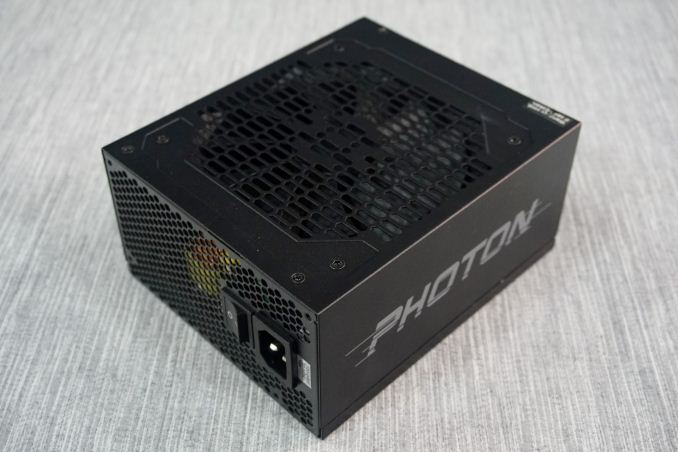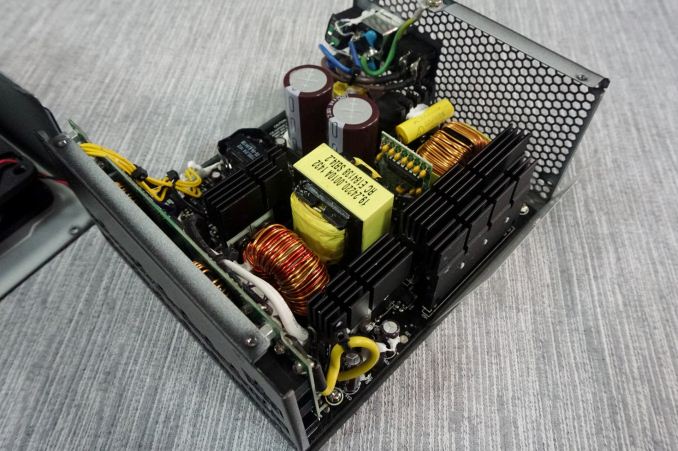The Rosewill Photon 1050W Review
by E. Fylladitakis on March 24, 2015 8:00 AM EST- Posted in
- Cases/Cooling/PSUs
- Rosewill
- 1050W
- Sirfa
External Appearance
The only thing that truly differentiates the Rosewill Photon from any other black PSU is the fan finger guard, which is not a separate part but an elongated honeycomb pattern punched on the steel chassis itself. Other than that, the series logo is printed on the right side of the chassis making it visible from a windowed side panel only if the PSU is installed with its fan facing upwards. There is absolutely nothing on the left side of the unit; the spectator will see only a plain, matte black surface from the side of a case if the unit is installed with its fan facing downwards. The sticker with the specifications of the PSU is found at the top side of the chassis.
Only the numerous connectors for the modular cables can be seen at the front of the chassis, with a basic printed legend indicating which connector corresponds to each cable. The CPU and PCI Express cables share the same connectors, while the split 10-14 pin connector is for the 24-pin ATX cable and the smaller connectors are for SATA/Molex cables.
Internal Design
A black 135mm fan from Globe is responsible for the cooling of the Photon 1050W. The B1352512H is a ball bearing fan with a maximum speed of 1500RPM, meaning that it can get significantly loud if the unit is heavily stressed. Of course, a thermal control circuitry adjusts the speed of the fan according to the load and the temperature of the unit, so we will examine how it truly behaves during our testing.
A look inside the Rosewill Photon 1050W instantly reveals that the OEM behind this unit is Sirfa, This is the same company who owns High Power as their own retail brand. Sirfa is not a bad OEM at all but it is not yet highly reputable among enthusiasts, mostly due to a few not-so-good low-cost designs they supplied through Sirtec in the past. The filtering stage is textbook, with four Y capacitors, two X capacitors and two filtering inductors. We also found a transient suppression diode and a classic fuse. There are two main rectifying bridges, sandwiched on a small, dedicated heatsink. Two large Nippon Chemi-Con 400V/390μF capacitors can be seen in the PFC stage, alongside an equally large filtering inductor. Two low resistance power transistors by Infineon form a half-bridge primary inversion stage, while eight transistors by the same company create the secondary conversion stage and generate the 12V output.
Quality wise, the Photon 1050W ranks above average, but it is not perfect. The quality of the components is outstanding; all of the main components come from reputable manufacturers - the electrolytic capacitors are all from Nippon Chemi-Con and the polymer capacitors are supplied by Fujitsu Electronics. Sirfa could improve their design and assembly quality a little though - the design is a little messy and there are several joints amateurishly soldered. These will not be a problem but they are also not something enthusiasts like to see in products that are supposed to compete in the high-end segment of the market.

























42 Comments
View All Comments
DanNeely - Tuesday, March 24, 2015 - link
Am I correct in thinking that this PSU, and other recent models capable of producing their entire output rating at 12V (give or take rounding on the amperage) are pure 12V designs internally that then use DC-DC converters to make the 3.3/5V rails instead of the traditional design that had separate circuitry for the 3.3/5v and 12v rail. With the older design having problems in cross load tests (when one side was maxed and the other only had a minimum load), the change in design seems a reasonable way to handle the shift of almost everything on the mobo to 12V operation; but I haven't seen it confirmed anywhere.MrCommunistGen - Tuesday, March 24, 2015 - link
Yes, many modern power supplies are built on a platform that only does AC to 12V DC, then use DC to DC conversion to get the 5V and 3.3V rails. I can think of all kinds of reasons that might provide cleaner power or be more efficient, but I'll leave that discussion to the experts.DanNeely - Tuesday, March 24, 2015 - link
Is the -12V (used for RS232) done that way too, or does it still get a special side circuit like the 5V standby.Gigaplex - Tuesday, March 24, 2015 - link
Why are the PSU reviews disproportionately focusing on 1kW and higher units? Even a high end SLI/Crossfire rig will struggle to load these PSUs. Especially with Intel and NVIDIAs latest power efficient architecture. How about some more reviews on units likely to be utilised by us mere mortals not doing quad Titan SLI?chlamchowder - Tuesday, March 24, 2015 - link
I agree. It's cool to read about ridiculously high end units. But few people are using dual graphics cards, and even fewer are going with more. I'd love to see reviews on lower priced units.For example, I recently built a computer with <400W power requirements. So, I got a $40 EVGA 500W supply - the cheapest 80+ supply I could find. There were approximately zero reviews of that unit on review sites (but plenty of user reviews on Newegg, for what that's worth).
For anyone who's wondering, that supply (100-W1-0500-KR R) is nice and quiet, even when feeding an overclocked FX-8350.
TomWomack - Tuesday, March 24, 2015 - link
I agree entirely; a review of PSUs starting from the absolutely cheapest, determining which ones work adequately, would be really useful. An i7/4790K with 16G memory and an SSD is a 150W system; to learn, with the kind of confidence that one of Anandtech's comprehensive reviews provide, that a $20 PSU from newegg is adequate would be quite helpful.jabber - Tuesday, March 24, 2015 - link
Hear hear! The number of people who look at this site that really really need such a PSU is probably less than 5%. Please lets have more reviews in the 450-750W range.jabber - Tuesday, March 24, 2015 - link
Oh and some nice reviews of specialist 200-400W would be good too.FunBunny2 - Saturday, March 28, 2015 - link
Yeah, but... AT's New Overseers clearly are going down the Apple Road: cater to the 20% rich and dumb enough to drop large coin on useless bling.gsuburban - Sunday, June 28, 2015 - link
Agreed. I don't use graphics cards any longer for computing, Intel HD Graphics will do. Thus, a PSU's total wattage isn't a main focus while the quality of it is. 650 watts is our limit in the long run for a non-discrete graphics machine and 750 to 850 with one.